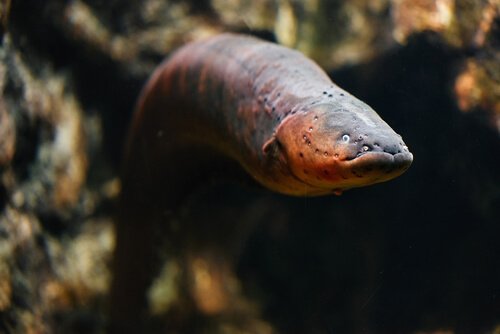Characteristics of the Eel - Should We Be Afraid Of It?

The eel is quite easy to identify because it looks like a swimming snake that hangs out in rivers and seas. Some of them could easily harm another animal due to their ability to deliver electric shocks. Learn all about them in this article.
General characteristics of the eel
The eel family is made up of fish that inhabit both fresh and saltwater bodies of water (euryhaline). They’re distributed in both tropical and temperate waters of the Pacific and Atlantic.
These animals go back to prehistoric times, and people have found fossils that they believe are about 20 million years old. The main characteristic of these fish is their elongated body that measures between around 30 and 80 inches. Note that females are larger and their skin is covered by a mucous secretion that makes them slippery.
In addition, eels have greenish-brown, nearly black, microscopic scales, and the belly is yellow or white. There are two small fins behind the head.
A rather shocking animal
These animals can travel over 2600 miles to spawn in the sea – unlike salmon, who only lay their eggs in rivers. Once in a place that meets specific characteristics (up to 1640 feet deep and around 60°F), they reproduce and die after copulating and laying their eggs.
Then, the eggs hatch a few days later and move through the sea currents to reach the river beds again. It takes them up to four years to reach their new home.
Upon contact with freshwater, they undergo the metamorphosis that transforms them into eels. A curious fact is that individuals will be either male or female depending on the salinity of the water (males if the water is saltier).
The eel is omnivorous but feeds mainly on small fish, crustaceans, mollusks, worms, and insects.

The European eel
This is one of the most popular eel species and common in the northern Atlantic Ocean and European seas. Moreover, this animal measures up to about 50 inches and weighs about 16 pounds; it has no spikes and its lower jaw is longer than the upper one. It has a kind of fin that goes from the anus to the middle of the back.
They arrive in the Sargasso Sea to reproduce at the end of winter. The larvae stay there for ten months and then travel to the coasts of Europe with the Gulf currents. Then, they return to the sea when they’re adults and don’t eat during this time.
The North American eel
This migratory fish inhabits the eastern coast of North America and has a slender body covered with a mucous layer. The fins of the American eel are attached to each other, as in its European relative.
Their bodies have several colors such as yellow, green, light gray, brown, or olive green but the belly is always lighter than the back. The coloration depends on the tone of the water where they live.
They travel to the ocean in order to reproduce and the females lay up to four million floating eggs and die after all of that work. Hatching takes place about ten weeks later and the larvae travel to freshwater systems such as the Hudson River and Chesapeake Bay to mature.
The electric eel
This animal isn’t a direct relative of other eels but shares some of the physical characteristics. They have a long, greenish body and a tooth-covered mouth with a lower jaw that’s more prominent than the upper jaw, for example.
In addition, the electric eel can emit shocks of up to 850 volts with its special cells. This is to hunt its prey, defend itself, and even communicate with others of its species – it can maintain a shock for a minute at a time.
Finally, this kind of “eel” inhabits the Amazon and Orinoco river basins in South America and prefers quiet areas with swampy soils. The largest known specimens measured about 98 inches and weighed over 40 pounds.